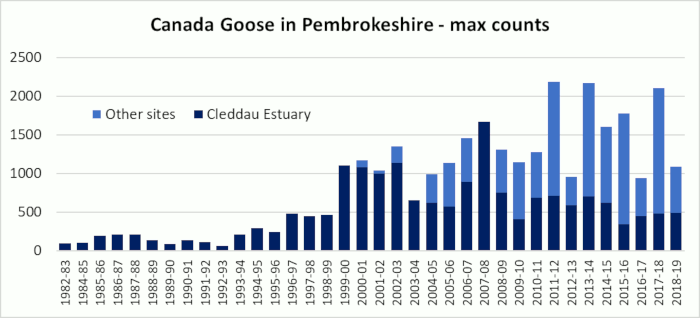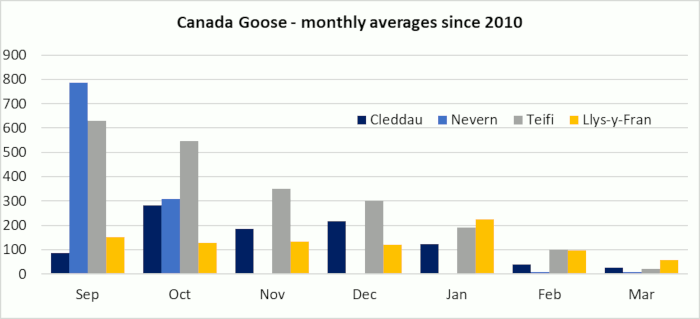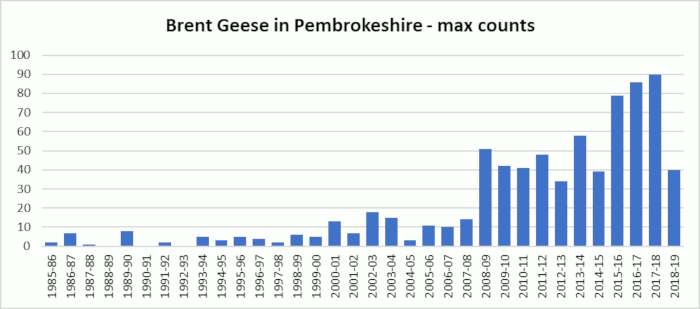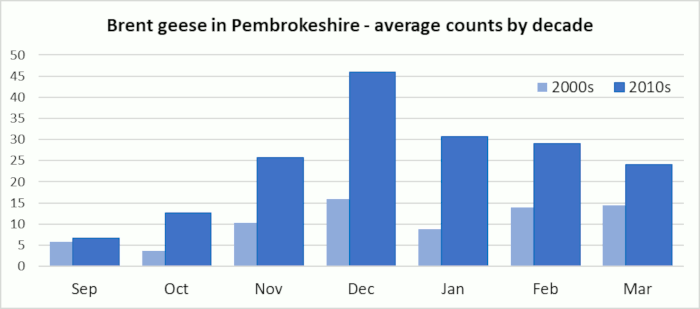Red-breasted Flycatcher - 2015 Skokholm
 Tuesday, February 25, 2020 at 6:14PM
Tuesday, February 25, 2020 at 6:14PM
 Pembrokeshire Avifauna committee | Comments Off |
Pembrokeshire Avifauna committee | Comments Off |  Rarity,
Rarity,  Skokholm in
Skokholm in  Red-breasted Flycatcher
Red-breasted Flycatcher  Tuesday, February 25, 2020 at 6:14PM
Tuesday, February 25, 2020 at 6:14PM
 Rarity,
Rarity,  Skokholm in
Skokholm in  Red-breasted Flycatcher
Red-breasted Flycatcher  Tuesday, February 25, 2020 at 6:03PM
Tuesday, February 25, 2020 at 6:03PM  Rarity,
Rarity,  Skokholm,
Skokholm,  warbler in
warbler in  Barred Warbler
Barred Warbler  Tuesday, February 25, 2020 at 3:40PM
Tuesday, February 25, 2020 at 3:40PM Vagrant - no previous island records
A vocal juvenile which circled North Plain in heavy drizzle on the evening of 20th September was seen and heard sufficiently well to confirm the identification before it roosted on the back of North Pond 50 (RDB, GE, BB, et al.). The bird was seen in flight and heard several times the following morning, although it did not settle and good views seemed unlikely. However the arrival of a juvenile Dunlin appeared to relax the dowitcher and they fed together during the afternoon of the 21st. It was not seen to leave North Pond for the next three days and generally fed alone from the 22nd. There was no sign of it on the 25th following a calm and clear night.
Phot (c) Richard Brown from Skokholm blog
This was the first record for Skokholm and only the third for Pembrokeshire following first-winter birds at the Gann between 12th December 1987 and 3rd January 1988 and between 1st January and 23rd March 2013 (Rees, 2014).
Skokholm Bird Observatory Annual Report 2015 (Richard Brown & Giselle Eagle)
 Skokholm,
Skokholm,  Wader,
Wader,  vagrant in
vagrant in  Long-billed Dowitcher
Long-billed Dowitcher  Tuesday, February 25, 2020 at 3:37PM
Tuesday, February 25, 2020 at 3:37PM Vagrant - no previous island records
Two summer plumaged birds found on North Pond during 9th June were the first record for Skokholm and the first spring record for Pembrokeshire (SWR, PTI, RDB et al.). They were still present the following day but were not seen on the 11th.
Photos etc on Skokholm blog
The four previous Pembrokeshire records were a first-winter shot on a farm pond near St Twynells in c.1900 (the specimen was confirmed as this species in 1928), singles off St Ann’s Head on 19th September 1950 and at the Gann on 16th September 1957 and most recently a juvenile on a slurry pond at Haroldston West on the 4th and 5th October 1983 (Rees, 2011).
Nationally 2015 was an exceptional year for passage records of this species and it proved a record breeding year in Shetland.
Skokholm Bird Observatory Annual Report 2015 (Richard Brown& Giselle Eagle)
 Skokholm,
Skokholm,  Wader,
Wader,  vagrant in
vagrant in  Red-necked Phalarope
Red-necked Phalarope  Tuesday, February 25, 2020 at 2:55PM
Tuesday, February 25, 2020 at 2:55PM Rare. Three records prior to 2000 when a small feral population established on Skokholm
One on North Plain on the evening of 5th April 2015 was the first since 2010 (HD et al.).
In June 2000 four pinioned birds reached Skokholm, three of the emaciated individuals making it to the plateau where they were fed. The following year two of the birds paired and produced four free-flying offspring. One of the adults and three of the young survived to 2003 and the three young were regularly seen with Canada Geese around the Marloes Peninsula in 2004.
Two birds were seen in 2005, 2006 and 2007, with one pairing with a Canada Goose in the latter year and producing [5] infertile eggs. A single was logged in 2008, 2009 and 2010, again pairing unsuccessfully with a Canada Goose in the latter two years.
The other Skokholm records are three immatures on 13 June 1971, a Slimbridge ringed bird on 9th May 1975 and five white adults north with four Barnacle Geese on 15th April 1991.
Skokholm Bird Observatory Annual Report 2015 (Richard Brown & Giselle Eagle)
 Skokholm,
Skokholm,  wildfowl in
wildfowl in  Snow Goose
Snow Goose  Tuesday, February 25, 2020 at 9:29AM
Tuesday, February 25, 2020 at 9:29AM
 The peak of 1669 on the Cleddau occurred in June 2007. The peak during the 'normal' count season of September to March was 651 in December that year. During the 2010s, the peak count on the Cleddau has been in June or July.
The peak of 1669 on the Cleddau occurred in June 2007. The peak during the 'normal' count season of September to March was 651 in December that year. During the 2010s, the peak count on the Cleddau has been in June or July.

Canada Geese did not appear regularly in WeBS counts on the Nevern Estuary until 2003-04. Maximum counts of between 1250 and 1500 have occurred several times in September-October since 2013-14. Counts are still low outside of this period, with none recorded in November-January, although there have been occasional counts of less than a dozen in mid-winter on non-count days.
Counts on the Teifi Estuary have numbered in the 100s since 2000, steadily increasing to 1000 in September 2010-11. Since then, there have been several counts of over 1000, all in the September-November period. It is possible that these are birds that were at the Nevern earlier in the season.
Generally small numbers (less than 50) occur on fresh-water sites. However they are more regular on LLys-y-Fran (up to 400) and on Marloes Mere (370 in 2010-11 but more usually less than 100).
Counts of Canada Geese can be surprisingly low at any site due to their habit of moving away to feed in fields, often some distance from the water, during the day.
National trend
The WeBS national trend for Canada Goose show a massive increase in the Welsh population in the late 1990s, however the overall British trend showed only a slow increase at that time. The English popluation remained relatively stable, suggesting that a part of the increasing population has moved to Wales.
Canada geese across Britain have shown a typical population curve of a “new” species, whether introduced by man or by natural expansion. Initially they remained at a relatively low level as the population established itself, followed by a rapid rise, and then (since around 2000) a levelling out as the population reaches the maximum carrying capacity of the habitat.
As the numbers of geese have increased, they have increasingly fed away from the estuary and are often missed during a count. This may account for a low peak number in some years, and it is difficult to know if this is a true indication of the population change, or just half the birds being elsewhere.
Are they causing a problem?
Some studies have been undertaken in other parts of the country regarding their effect on other wild birds using the same water bodies. This research suggests that even large numbers of Canada geese have no effect on other species of wildfowl. The increased population on the Cleddau does not, at present, appear to be having any effect on the overall numbers of wildfowl in the areas they occur. However, there may be an effect on the vegetation from trampling and eutrophication.
 Goose,
Goose,  WeBS,
WeBS,  wildfowl in
wildfowl in  Canada Goose
Canada Goose  Saturday, February 22, 2020 at 6:01PM
Saturday, February 22, 2020 at 6:01PM Brent geese were occasional visitors to Pembrokeshire before 1990, and only began to appear regularly on WeBS counts in1993-94 as shown below.


The highest numbers in any season are recorded between December and February
Almost all brent geese are seen on the Cleddau, especially at the Gann or at Angle Bay. Just a handful are counted on the Nevern and Teifi.
As the birds commute - either in a flock, or in small groups - between the Gann and Angle Bay - it is possible that they can be double-counted at times. However, an individual count of 77 at Angle Bay in December 2016, (and other individual counts - 68 at the Gann in 2012 and 62 at Angle Bay in 2017 - on non-WeBS days) that suggest the WeBS totals are reasonable.
Almost all birds are of the light-bellied race (hrota) - with just a handful of dark-bellied birds recorded.
Many ringed birds have been observed, and these prove movements between Ireland (main ringing station), Pembrokeshire and Brittany, and to north-east Canada (breeding grounds) via Iceland and Greenland.
AH
Pembrokeshire WeBS coordinator
 WeBS,
WeBS,  wildfowl,
wildfowl,  winter in
winter in  Brent Goose
Brent Goose  Saturday, December 14, 2019 at 8:25PM
Saturday, December 14, 2019 at 8:25PM White Wagtails subspecies alba pass through Pembrokeshire in both spring (from March to May) and autumn (late August to October), sometimes in considerable numbers, such as 200 at Skokholm on 15 September 1988. Many of these originate in Iceland, judging by ringing recoveries, but it is likely that others are Scandinavian, as their passage coincides with the occurrence of other species from that area, such as Grey-headed Wagtails, Scandinavian Rock Pipits and Bluethroats. Ringing also shows that birds passing through Pembrokeshire journey on to France and Spain on the return migration.
 1994 BoP in
1994 BoP in  Pied/White Wagtail
Pied/White Wagtail  Saturday, December 14, 2019 at 7:49PM
Saturday, December 14, 2019 at 7:49PM Masked Wagtail M. a. personata, a well watched bird at Camrose between 29th November and 26th December 2016 (J. Hudson et al) was accepted by the BBRC as the first record of this race in the UK.
 vagrant in
vagrant in  Pied/White Wagtail
Pied/White Wagtail  Saturday, December 14, 2019 at 6:45PM
Saturday, December 14, 2019 at 6:45PM
 Occasional visitor in
Occasional visitor in  Hawfinch
Hawfinch  Saturday, December 14, 2019 at 6:40PM
Saturday, December 14, 2019 at 6:40PM
 Rarity in
Rarity in  Dark-eyed Junco
Dark-eyed Junco  Saturday, December 14, 2019 at 6:36PM
Saturday, December 14, 2019 at 6:36PM A singing male on Skokholm on 18th June 2017 was caught there and ringed. Accepted by BBRC.
 Rarity in
Rarity in  Yellow-rumped Warbler
Yellow-rumped Warbler